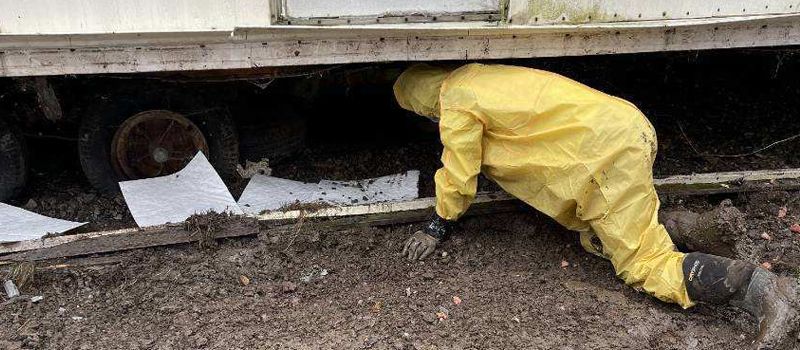Incident Response Plan Framework for Hazardous Spills
This is a info alert
This is a danger alert
This is a success alert
This is a warning alert
This is a dark alert

Introduction
An Incident Response Plan (IRP) is essential for effectively managing hazardous spills, ensuring compliance with environmental regulations, and minimizing risks to human health and property. This framework provides a structured approach for businesses, municipalities, and response teams to develop a customized spill response plan.
1. Incident Response Team (IRT) Roles & Responsibilities
A. Key Team Members
Incident Commander (IC) – Oversees the response, coordinates with agencies, and makes final decisions.
Safety Officer – Ensures personnel safety and enforces PPE requirements.
Operations Lead – Directs containment and cleanup operations.
Communications Coordinator – Handles internal and external reporting, including regulatory notifications.
Logistics Coordinator – Manages resources, spill kits, and equipment.
Environmental Compliance Officer – Ensures regulatory compliance and proper documentation.
B. Contact List & Emergency Numbers
Local Fire Department Hazmat Unit
New York State DEC Spill Hotline – 1-800-457-7362
EPA Emergency Response – 1-800-424-8802
Local Emergency Management Contacts
2. Spill Classification & Risk Assessment
A. Spill Severity Levels
Level 1 (Small-scale, low hazard) – Minor spills that can be managed with in-house resources (e.g., minor oil leak).
Level 2 (Medium-scale, moderate hazard) – Spills requiring outside assistance but no immediate public hazard (e.g., warehouse chemical leak).
Level 3 (Large-scale, high hazard) – Spills involving dangerous materials, large areas, or requiring multi-agency coordination (e.g., tanker spill in a waterway).
B. Risk Assessment Checklist
Identify substance type and hazard level (SDS reference).
Determine exposure risks (airborne, water contamination, flammability).
Assess spill volume and affected area.
Check for proximity to water sources, drains, or sensitive environments.
3. Response Procedures
A. Immediate Response Actions
Ensure personal safety – Evacuate as necessary and wear proper PPE.
Secure the spill site – Prevent unauthorized access.
Identify the spilled substance – Use SDS and labels.
Deploy containment measures – Use absorbents, berms, and barriers.
Notify the appropriate agencies – Based on spill severity.
B. Containment & Cleanup Steps
Solid Spills – Sweep and contain in hazardous waste containers.
Liquid Spills – Use absorbents, neutralizers, and drainage protections.
Airborne Contaminants – Close ventilation, use respirators, and isolate the area.
Waterway Spills – Deploy floating booms and notify environmental agencies immediately.
C. Post-Spill Cleanup & Decontamination
Collect and dispose of hazardous waste properly.
Conduct air, soil, and water quality testing.
Implement site decontamination procedures.
4. Reporting & Documentation Requirements
A. Internal Reporting
Complete an Incident Report Form detailing:
Date, time, and location.
Substance spilled and estimated volume.
Response actions taken.
Personnel involved.
B. Regulatory Compliance Reports
Spills exceeding reporting thresholds must be reported to:
New York State DEC – 1-800-457-7362.
EPA National Response Center – 1-800-424-8802.
Local county or municipal environmental offices.
Maintain records for regulatory audits and insurance claims.
5. Prevention & Preparedness Measures
A. Spill Prevention Plan (SPCC Plan)
Store hazardous materials in labeled, secondary containment systems.
Conduct routine equipment inspections for leaks or weaknesses.
Train employees in hazard communication and emergency response.
B. Emergency Preparedness Training
Quarterly spill response drills for all employees.
Coordination with local emergency services for joint training exercises.
Ensure all personnel know evacuation routes and emergency contacts.
6. Post-Incident Review & Improvement
A. Lessons Learned Process
Conduct a post-incident debriefing within 48 hours.
Identify response strengths and weaknesses.
Update the Incident Response Plan based on findings.
B. Continuous Improvement Strategies
Regularly review and update spill prevention and response protocols.
Invest in new containment technologies as needed.
Foster a safety-first culture through ongoing training.
Conclusion
A well-structured Incident Response Plan is critical for minimizing the impact of hazardous spills. By assigning clear responsibilities, following structured response procedures, and maintaining compliance with state and federal regulations, organizations can ensure a swift, effective, and legally compliant spill response.
For additional guidance, consult with local environmental agencies and hazardous materials experts to tailor this framework to your specific operational needs.
🔄 Next Steps in Spill Preparedness & Response
Looking to deepen your understanding or take action? Explore these related resources:







